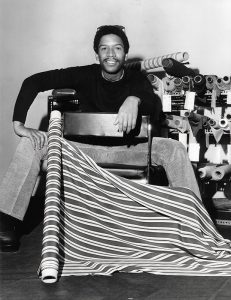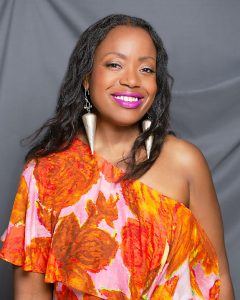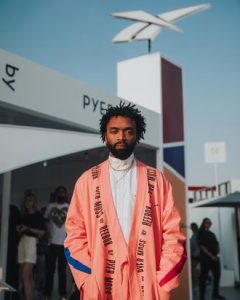The fashion industry has not always honored the accomplishments of some of fashion’s most influential Black contributors. Historically, Black creators, designers, and crafts-people have been the driving force behind some of fashion’s most notable moments, but too often recognition falls short of those who deserve it. The Jefferson Fashion Department celebrates the accomplishments of all designers, regardless of their race, age, gender, or sexual orientation. In celebration of Black History Month, we are highlighting only a few of many Black designers who have helped shape and progress our fashion landscape. Check out the list below and click the designer’s name to read more.

Virgil Abloh was a Chicago-born designer and entrepreneur named by Time magazine as one of the 100 most influential people in the world in 2018. The designer challenged current perceptions of “luxury fashion” by elevating streetwear to a higher status, and in turn altered how traditionally Black fashion is viewed within the industry as a whole. Abloh was CEO of Milan-based fashion brand Off-White, which he founded in 2013. He was also named the first African-American artistic director of menswear at Louis Vuitton in March 2018. Virgil Abloh passed away unexpectedly in 2021 at the young age of 41 after a private battle with cancer.

Jay Jaxon’s love for clothing and fashion began as an adolescent while babysitting for a family on his block, joining them as they made their own clothes. Making his way to Paris in 1968, Jaxon spent time working under industry icons such as Yves Saint Laurent, Christian Dior, and Jean-Louis Scherrer. He was the first African American and first American couturier to lead a French couture house at Jean-Louis Scherrer. Jaxon is also known for creating Annie Lenox’s 1984 suit for the Grammy Awards, as well as costume designs for TV shows such as Ally McBeal, Sabrina: The Teenage Witch, and American Dreams.

Mississippi-born Patrick Kelly found success for himself and his brand in Paris, France. Kelly is known for pushing racial and cultural boundaries with his fashion, and wanted women of color to see fashion as a equal-opportunity space for joy and celebration. With a focus on body-conscious matte jersey silhouettes, Kelly’s designs often feature bows, hearts, enlarged buttons, and other embellishments. Kelly is the first American designer to be named to the Fédération de la Haute Couture et de la Mode, France’s federation of couture and high fashion designers.

Ann Lowe is perhaps one of the greatest American couture designers of all time. Creating beautiful, fitted gowns, often featuring three-dimensional floral elements, Lowe’s garments are works of beauty, both inside and out. Lowe designed one of the most photographed wedding dresses of all time: the iconic wedding gown belonging to Jackie Kennedy. At the time, she was not recognized publicly as the designer of the dress and was often paid substantially less than her white counterparts.

Designer Willi Smith is often credited with “inventing” streetwear, marrying elements of avant-garde art and fashion with more affordable fabrics and construction. In 1974, Smith founded Willi Wear Ltd. with creative partner Laurie Mallet and produced clothing, events, and experiences with collaborators across multiple fields, ultimately creating a brand focused on social change. Smith died in 1987 from AIDS complications, but left his legacy as the most commercially successful Black American designer of the 20th century.

Zelda Wynn Valdes, born in Pennsylvania in 1905, worked her way from a storeroom worker at a boutique up to seamstress during a time when segregation was still heavily present in society. Opening her own boutique in 1948, she became the first black woman to own a store on Broadway in New York City. Valdes’s designs, often featuring low-cut and body-hugging silhouettes, and were popular with jazz musicians and Black actresses at the time. Her ability to accentuate women’s curves was even acknowledges by Hugh Hefner, who commissioned the designer to create the iconic Playboy Bunny suit.

Ruby Bailey was a Bermuda-born designer, artist, and actress whose flamboyant sense of style was well-known around Harlem. She was a contemporary to Zelda Wynn Valdes, both members of the National Association of Fashion and Accessory Designers- an organization founded to give black designers more influence in the fashion industry. Bailey’s bold artistic expression was displayed through her incredibly detailed beading and embroidery, as well as her reimagining of traditional African prints.

Designer Steven Burrows rose to prominence in the 1970s with his graphic, color-blocked dresses made of matte jersey. He is also credited with inventing the “lettuce edge” hem, which creates a curled fabric edge caused by overstretching the jersey fabric base. Burrows’ designs are known for their soft, stretchy characteristics, which made them perfect ensembles for disco-dancing and nightlife. He became the first Black designer to win a Coty award in 1973.

Tracy Reese has been a fixture in fashion runway and retail since her brand’s launch in 1998. She was added as a board member for the CFDA in 2007, and continues in this position today. Reese’s brand focuses on inclusivity and sustainability. The designer’s line Hope for Flowers is based in her hometown of Detroit and produced in a small factory in Flint, Michigan. The factory is noted for employing women who want to learn new skills and reenter the workforce.

Sean Combs, also known by stage names P.Diddy and Puff Daddy, is a multifaceted American entrepreneur. Combs got his start working at various record labels before founding his own label in 1993, and ultimately launching an incredibly successful music career for himself in 1997. Building on this success, Combs released his Sean John clothing label specializing in urban streetwear in 1998. The brand was notable for dressing some of music and Hollywood’s biggest stars throughout the early 2000s. Today, the brand is experiencing a resurgence, as Combs recently bid $3.3 million to buy the brand back from the company that currently holds majority ownership.

Patrick Robinson has been a member of the CFDA since 1994, and is a notable American contemporary designer. After graduating from Parsons, he worked as a designer for companies such as Giorgio Armani, Paco Rabanne and Perry Ellis. He is also widely regarded as the designer to revamp the GAP label in 2007. Today, Robinson operates his own sustainably-minded fashion brand Pashko, which recently moved production to the USA to alleviate soaring unemployment rates in domestic clothing production as a result of the COVID pandemic.

Queens-born LaQuan Smith started his brand at the age of 21, and is making a name for himself among New York’s fashion elite. Smith designs for a customer who likes being the center of attention, so its no surprise that fashion risk-takers such as Lady Gaga, Kim Kardashian, Rihanna, and Beyoncé are among his clientele. One of ten finalists of the 2021 CFDA Fashion Fund, Smith is working to expand his product categories and prepare for future growth.

Telfar Clemens is quickly making a name for himself in New York’s fashion scene. The Liberian-American designer started in the industry by creating his own collection from deconstructed vintage pieces in 2003. Since then, Clemens has launched Telfar, a genderless fashion label based in Brooklyn. The designer’s signature Telfar Shopping bag has received global recognition, and has been nicknamed the “Bushwick Birkin” for its popularity among the hip and fashionable in New York City.

Aurora James is a Black Canadian designer and the founder of Brothers Vellies, a brand centered on promoting the work of skilled laborers around the world, including Africa and South America. In 2020, James launched the 15 Percent Pledge initiative, a non-profit organization urging major retailers to commit 15 percent of shelf-space to Black owned businesses. The Brother Vellies brand has been worn by a number of notable activists, artists, and celebrities, including Beyonce, Solange Knowles, Nicki Minaj, and Elaine Welteroth. Aurora James also designed the “Tax the Rich” dress worn by Alexandria Ocasio-Cortez at the 2021 Met Gala.

Designer Christopher John Rogers is on a trajectory of greatness. In 2021 alone, the designer was awarded the CFDA Award for Womenswear Designer of the Year; designed a hugely successful Target collaboration; was featured on the Gossip Girl reboot and at the Met’s Costume Institute; and made the LVMH Prize. For Rogers, fashion is a way for people to express themselves without having to fit into a nice, neat box. “I don’t like making things that are too classic or too clean, there always has to be something off about it because I think that allows you the space to relax,” says the designer.

Haitian-born designer Victor Glemaud launched his namesake label in 2008. Known for his knitwear designs, Glemaud was a 2017 CFDA/ Vogue Fashion Fund finalist. Getting his start in fashion, Glemaud worked under Patrick Robinson, as well as with brands such as Versace, Marc Jacobs, and Helmut Lang. Glemaud’s suggestion for every design studio is to hire people of diverse backgrounds and/or with non-traditional resumes. “Untapped talent will introduce fresh perspectives, ideas, and energy,” he says.

In 2011, music icon Rihanna first dipped her toes into the fashion industry with a capsule collection of T-shirts, biker jackets, denim, and lingerie for Emporio Armani Underwear and Armani Jeans. Hired as Puma’s creative director in 2014, the star has since collaborated with numerous luxury brands to launch exclusive product. Today, Rihanna continues to release lingerie through the Savage x Fenty label, and has a line of beauty called Fenty. In 2019, the signer and LVMH announced plans for a collection which will span ready-to-wear, leather goods and accessories. That project has since been put on hold, with Rihanna focusing on expanding the Savage x Fenty line.

Kerby Jean-Raymond is the founder and creative director of Pyer Moss based in New York. The purpose of the brand is to use personal storytelling to “engage with the past, present, and future of the Black American experience.” Jean-Raymond began his design career freelancing for Theory, Marc Jacobs, Badgley Mischka, and Kenneth Cole before founding Pyer Moss in 2013. In 2018, Jean-Raymond and his brand earned notable recognition from the CFDA’s Swarovski Award for Emerging Talent, the CFDA/Vogue Fashion Fund, and Collaboration of the Year at the Footwear News Achievement Awards for his work with Reebok. In September 2020, Jean-Raymond was named as global creative director for the footwear brand.

When Shayne Oliver launched Hood by Air in the early 2010s, the designer introduced the fashion world to a new perspective on Black thought and queerness. The brand takes inspiration from 90s streetwear, and is a favorite of many celebrities and musicians. After a three-year hiatus, Oliver relaunched the brand in 2020, taking a new approach to supporting BIPOC emerging talent and direct-to consumer connections.

Dapper Dan, also known as Daniel Day, opened his Harlem couturier in 1982, and was a favorite for local gamblers, gangsters, hip-hop artists, and athletes. The designer is known as the pioneer of luxury streetwear, recognizing the importance of monograms and logos to high-end fashion and status. Dapper Dan was known to reworking luxury pieces (such as Gucci, Louis Vuitton, and others) into new silhouettes which were highly coveted by his clients. However, luxury brands has the shop raided by police in the late 1980s for licensing issues. In 2017, Gucci redesigned one of Dapper Dan’s puff-sleeved bomber jacket silhouettes and presented it as its own on the runway, creating an uproar from the fashion community. In an effort to make right, Gucci invited the designer to create a capsule collection and sponsored a new appointment-only atelier in Harlem as a tribute to him. “I describe what I did as coming up a black staircase, as opposed to what Naomi Campbell or [Vogue editor] André Leon Talley did, which was come up a white staircase,” he says.

Edward Wilkerson’s love for fashion started in high school, where a teacher encouraged him to pursue a career in design. Working for Anne Klein, Donna Karan, and Calvin Klein at his start, Wilkerson is now the longtime fashion director at Lafayette 148.

Bryon Lars first launched his collection of “twisted American classics” in 1991. The designer’s unique style combines elements from multiple areas of inspiration to create new and exciting silhouettes. In Spring 2021, Lars launched IN EARNEST, which combines many influences from his 4-year long design cooperative with XIAO CHONG in China. Lars is also responsible for Mattel’s first collection of African American Barbie Dolls, which authentically represented the hair, complexion, and style of these women. In total, Lars designed 16 Barbie dolls between 1995 and 2011.

New York designer Fe Noel is a self-taught and finding success among the city’s fashion favorites. Opening a boutique in Crown Heights at the age of 19, she often felt like the clothes she wanted to sell were not readily available to market. This inspired her to begin designing bright, joyful clothing. The brand’s motto “Eat well, travel often and dress to inspire”, reflects the clothing’s sense of freedom and positivity.

Gordon Henderson learned to sew by watching his mother create dresses for herself from Vogue patterns. After graduating Parsons in 1983, he continued in the industry as an assistant designer for Calvin Klein. In 1987, he launched his own namesake line, and landed an exclusive deal with Saks Fifth Avenue. People magazine named him “fashion’s man for the woman who works.”


Designer Alvin Bell is a Philadelphia native who was close friends with designer Willi Smith. For many years, Bells worked as an illustrator and photojournalist, and was hired as the illustrator for Alfred Angelo Bridal and many other designers at the time. In 1997, Bell was hired to design and launch a collection of casual and career wear for women called Mosaic by Sears Roebuck & Company.








Add comment